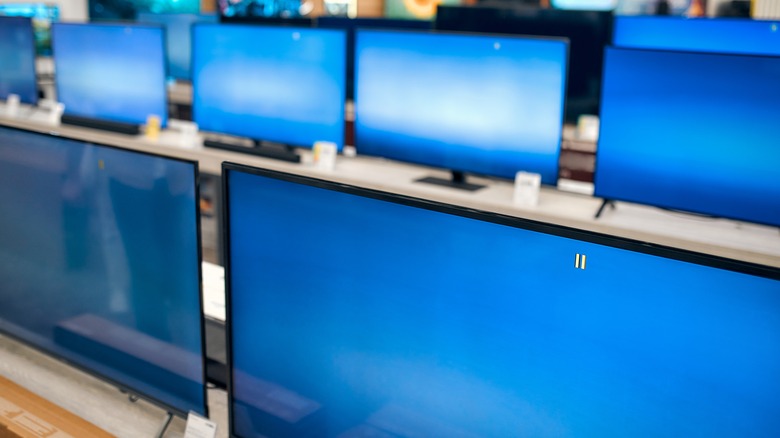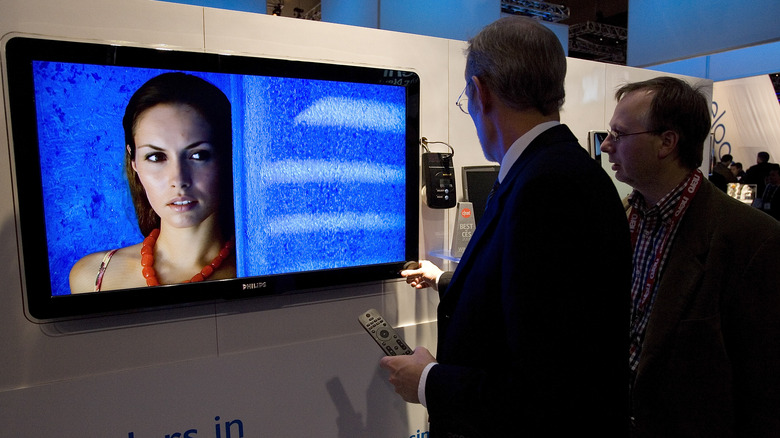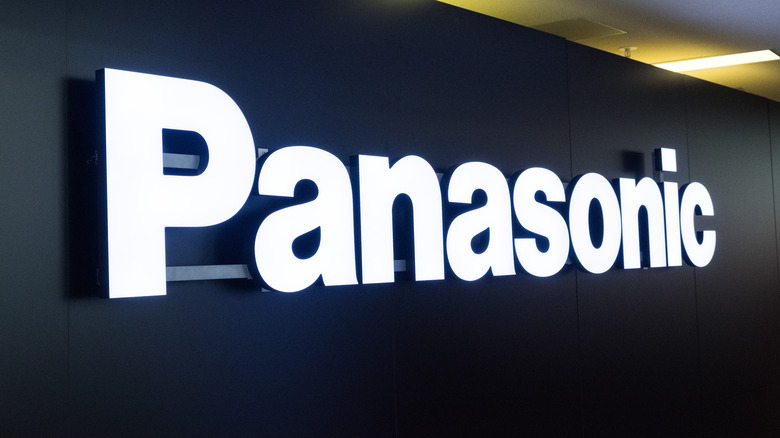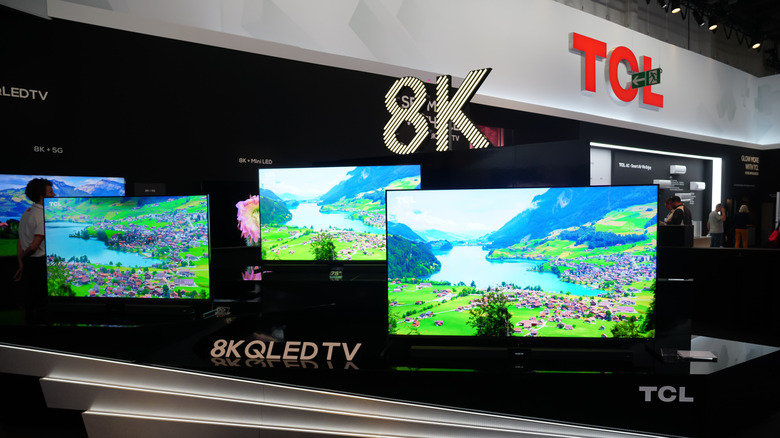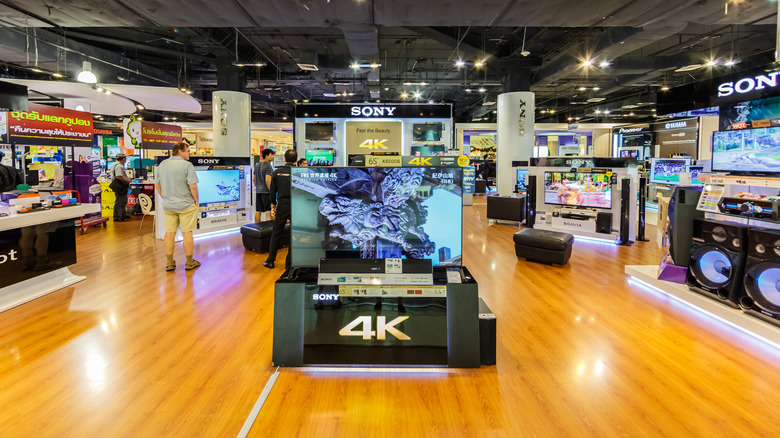12 Major TV Brands Ranked Worst To Best By Customer Satisfaction
Televisions have been a part of peoples' lives of people dating back several decades. Throughout that time, the television market has been rife with innovation. Whether the television is used for binge-watching shows on one of several streaming platforms, gaming, or watching sports, consumers are spoiled for choice as far as top television brands are concerned. However, choosing the ideal TV is not a one-size-fits-all process.
There are several factors to weigh when deciding on the optimal TV, specifically, a go-to brand. Size, resolution, features, and smart TV interface are just a few factors consumers need to consider when thinking of purchasing a new television. Naturally, the best television brands serve several masters and provide a slew of reasons for consumers to come to the table, whether through value relative to cost or being at the forefront of innovation. Additionally, while many of the world's top brands are backed by decades of favorable sales figures, the fast risers and fallers of today's market signify a need for consumers to identify which brands to target and avoid. Here are 12 of the world's most recognizable television brands ranked from worst to best.
We used a customer satisfaction ranking published by Consumer Reports to establish our rankings.
12.) RCA
RCA is known for producing one of the most cost-effective 4K televisions that money can buy. While this could be considered a positive to some consumers, there is also a reason why these are the cheapest 4K televisions on the market. RCA televisions, which Technicolor is currently producing under the RCA label, are known for their technical issues and low-quality performance that has not met the expectations of its consumers. Budget televisions are nothing new, and while there is something to the notion that "you get what you pay for," the negative consumer feedback makes this brand one to avoid, particularly when there are plenty of better 4K options on the market designed not to break the bank.
RCA televisions are typically 30 to 50 inches and have been criticized by consumers due to inconsistent picture quality and a narrow-angle of view. The screens are also capped at a 60Hz refresh rate, making RCA televisions sub-optimal for playing the current generation of video games. However, the television's design yields few issues, and the interface is simple and easy to pick up for first-time users. However, despite being one of the oldest electronics brands in American history, RCA's continued decline amongst its peers makes it one brand to avoid. Most modern RCA televisions cost under $600.
RCA may have been manufacturing televisions since the 1930s, but experience doesn't always translate to quality. It comes in last on our list, with a customer satisfaction score of 1/5.
11.) Insignia
Insignia, the Best Buy electronics brand, makes one of the best-selling budget televisions on the market. Most Insignias cost under $500. For those seeking a cheaper television with a larger screen size, Insignia is a viable option. They are also one of a handful of television manufacturers in the current market to support the Fire TV interface, a familiar look to many consumers. However, this brand falls short of quality when juxtaposed with its competitors from a technical standpoint. The device's 60Hz native refresh rate lags behind other comparable televisions. This and a lack of support for HDMI 2.1 ports could nudge consumers looking for a gaming television elsewhere. HDMI 2.1 allows for higher resolutions like 8K and higher, as well as frame rates of up to 120 FPS that are necessary for gamers looking to get the most out of ninth-generation consoles such as the Xbox Series X and PlayStation 5.
Insignia televisions also lack the same level of HDR support as its competitors, as it maxes out at HDR 10. Insignia products also lack local dimming, opting for a more cost-effective but worse-looking direct lighting. As a result, these televisions lack the contrast and highest peak brightness of other televisions in a comparable price range. Those looking for a second or third set in their home, perhaps for children, or a television for an office-type setup could do worse. However, consumers should not purchase an Insignia television with the expectation of receiving a top-shelf product.
Insignia joins two other brands at joint ninth, with a score of 2/5 in the Consumer Reports customer satisfaction survey.
10.) JVC
While JVC is a respected and reputable brand in global electronics, the Japanese company isn't one of the top major television brands in the world. It lacks the market share and sales volume of its competitors, and will never be confused for being a company on the cutting edge of innovation. However, the brand has cultivated a loyal customer base over its near centennial of existence. The company's televisions are affordable, durable devices, and should be considered an upgrade over Toshiba and Insignia brand televisions thanks to a higher pixel density, resolution, and its incorporation of Dolby Audio, a technology that produces a clearer, more enhanced sound.
One of the brand's drawbacks includes an inconsistency in worldwide distribution. JVC televisions are not as readily available in the United States as they are in other countries such as Australia and New Zealand, and therefore the choice of models could be limited for U.S. consumers. There is also an inconsistency in operating systems, as JVC utilizes one of several operating systems for its televisions depending on what region of the world they are made for. Furthermore, its technical specs cause it to fall short of its predominantly overseas competitors.
JVC scored just 2/5 in terms of customer satisfaction, putting it joint ninth on our list from a reliability standpoint.
9.) Philips
Philips follows JVC in not being accessible in all parts of the world. The Dutch company, despite having origins dating back to the 19th Century, does not currently manufacture televisions for an American audience, instead turning its attention primarily toward the European and Asian markets. As a result, it falls behind mainstream competitors such as Samsung, LG, Hisense, and Sony in terms of sales. However, Philips is still known to produce a quality product for its consumer base, offering a full array of display technologies (including OLED), the Ambilight feature, and competitive pricing. It also supports Dolby Vision.
Still, the Dutch company is not without its drawbacks on the television end. Philips' operating system, Android, leaves something to be desired despite its popularity as a user interface for cell phones. While Android televisions can provide users with better customization options and access to more applications, the UI lags behind other operating systems, and buyers have frequently reported problems with stuttering and buffering within the menus. Users are able to improve the frame rate of their UI by tinkering within the "Developer Settings" menu, but one could also argue this should not have been necessary to ensure a reliable, working television. Given its limited availability worldwide, consumers may want to look elsewhere in spite of Philips' history of innovation.
Philips comes in at joint ninth in customer satisfaction with a score of 2/5.
8.) Panasonic
Panasonic televisions are also not available in North America as of 2016, limiting the number of models that are accessible worldwide. However, it too makes the grade as far as offering a premium television viewing experience. Most Panasonic models are known for their durability and sustainability. OLED models are also available and the television takes full advantage of advanced audio technologies such as Dolby Atmos and DTS:X that lend to a higher quality sound than most of its competitors. Additionally, the HLG Photo Mode of Panasonic TVs is a must for photography and multimedia companies and enthusiasts thanks to its HDR quality.
Based on the quality of its features alone, Panasonic could be considered a top-four television brand, even without a North American consumer base. However, the brand still has its drawbacks, such as a dearth of selection in its app store compared to its competitors as well as its price point. Panasonic's user interface was formerly powered by Firefox, but after Mozilla discontinued its development of the UI in 2016, the company opted to make Android the new UI. The phrase, "You get what you pay for," still applies to Panasonic models, as consumers are bound to get a quality television, though it may not be the optimal choice depending on what region of the world one lives in.
7.) Toshiba
Toshiba's reputation in the television business is not what it used to be and has long since been purchased by Chinese manufacturer Hisense, another name present-day consumers might be familiar with. However, Toshiba continues to operate as a separate entity and may be the optimal television for those seeking the familiar look and feel of the Amazon Fire TV operating system without the Hisense prices or the cheap look of Amazon and Insignia televisions.
At the surface level, Toshiba falls short of some of the bigger brands in today's market, even with its long history as a global electronics manufacturer. However, it could be seen as an upgrade over Insignia thanks to a sleeker, more modern-looking design that fits nicely in most rooms. While neither of the competitor brands features the HDMI 2.1 ports that make for an optimal gaming experience, Toshiba televisions have a lower latency time when used in conjunction with modern consoles. Toshiba also has a slight edge in its port selection, offering four HDMI ports to Insignia's three. As a result, Toshiba televisions continue to have a leg up on Best Buy's Insignia brand in spite of their overwhelming similarities but fall short of other companies that produce a perennially better product.
Toshiba received an average score of 3/5 in Consumer Reports' customer satisfaction survey, placing it at joint 6th on this list.
6.) Hisense
Hisense has been around for more than 50 years, becoming the largest TV manufacturer in China by market share in 2004. The company has seen further growth by investing in name legacy brands such as Sharp and Toshiba, and is no slouch itself with its top model, the 65-inch Hisense U8H, holding up to some of the best televisions in the world. This particular model offers excellent picture quality, with support for HDR10, Dolby Vision, and HLG (Hybrid Log-Gamma) to provide a wider range of colors and deeper blacks. This television also uses Quantum Dot technology, which helps to improve color accuracy and vibrancy.
Hisense televisions do not measure up in every way, however, with one of its biggest drawbacks being a problem unique to its product: audio quality. Most televisions go above and beyond with audio quality, with features such as Dolby Atmos in tow to ensure an optimum audiovisual experience. However, Hisense televisions have exhibited a variety of audio issues, particularly with its lower-end models. Hisense televisions also use a VIDAA operating system. While VIDAA allows for several customization options to be implemented, the UI's app store once again limits the user's options. Ultimately, if consumers can live with the television's flimsy, brittle design, Hisense is a viable option for how well its picture quality compares to its competitors for the price, in addition to the company's willingness to add new features.
Hisense scored 3/5, putting it joint sixth in the rankings alongside Toshiba and the next brand on this list.
5.) Vizio
Vizio has become synonymous with its commitment to producing budget TVs, though this company also offers options for those looking to splurge. This company offers a better picture quality than some of the world's most popular budget brands such as Insignia and JVC, equipped with a true 4K resolution in addition to superior HDR support. Vizio also offers a handful of handy Smart TV features, including built-in accessibility for Google Chromecast, which allows consumers to easily stream video to their TV from various devices. The brand is an intermediate option for those wanting a quality television experience without spending LG or Sony money.
While Vizio may be the preferred budget television brand to many, the company's televisions are by no means perfect. Some consumers have reported issues with build quality and durability, and issues one would be hard-pressed to find with the latest models from brands such as Panasonic and JVC. Vizio televisions also suffer from similar problems to brands like Panasonic, such as a lack of quality app selection and a clunky user interface that could take some getting used to. Still, Vizio is not a brand worth writing off, especially considering it boasts one of the most affordable OLED televisions on the market currently.
Vizio is joint 6th, with a Consumer Reports satisfaction survey score of 3/5.
4.) TCL
Thanks to an emphasis on mini-QLED televisions in recent years, TCL (Telephone Communication Limited) has become one of the fastest-growing television brands in the world. These types of televisions are smaller and more compact than traditional models, making them an optimal choice for those looking for a quality viewing experience with limited space. TCL's mini-QLED models offer a range of advanced features, such as support for HDR10 and Dolby Vision in addition to the quantum dot technology that has become the brand's calling card. Despite its compact design, the mini-QLED is also available in larger sizes for no more than $700.
Recent market success has seen TCL rise among the ranks as a global television brand. However, customer frustrations with customer support, in addition to inconsistency with the out-of-the-box product, caps TCL from entering the top three. A lack of quality control over the final product has seen several consumers report dead pixels on the screen. Additionally, some models make use of cheaper materials that can result in screen bleeding or other defects. However, TCL's use of familiar operating systems such as Roku and Android should mitigate these problems for users looking for an easy-to-use and easily navigable UI. So long as the out-of-the-box product is without its defects, TCL marries affordable pricing with cutting-edge technology.
TCL scored a 4/5 in Consumer Reports' customer satisfaction survey.
3.) LG
Those looking for the highest quality television on the market should look no further than LG. On the other hand, those looking to buy a sustainable over-performing budget television should also consider LG. The South Korean brand makes televisions for all types of consumers around the world and frequently steers into innovation, with LG's OLED model standing out as an industry leader, even as the technology becomes more prevalent and affordable. LG took an educated gamble on OLED technology back in 2013 and is now responsible for more than 60% of OLED television sales. As impressive as LG's OLED televisions are, there are still plenty of reasons for those not looking for an OLED model to buy an LG.
The company has built a reputation for durable, aesthetically pleasing designs on all models. LG televisions also come with the LG Magic Remote, an intuitive remote control that incorporates point-and-click technology for faster, more efficient navigation. Those who prefer a more traditional television experience can still use the remote as is, however, and the company's webOS smart TV software stands out as one of the smoothest, easiest-to-use operating systems among all major television brands. In summation, LG's televisions have the visibility and inclusiveness necessary to be a major brand without the weaknesses and oversights major brands tend to make.
LG scored 5/5 in Consumer Reports' customer satisfaction survey, which puts it at the top of the list. However, it wasn't the only brand that received a maximum customer satisfaction score.
2.) Sony
Sony has managed to maintain a hold on the television market specifically thanks to high picture quality with all the modern innovations packed into sleek and modern designs. Sony's success in other areas of electronics, namely in the video game industry, has bolstered its television sales, particularly for PlayStation owners looking to pair their console with the optimal television to accompany it. As such, Sony devices make for great gaming televisions. These televisions also utilize a built-in feature known as Sony Music and proprietary Acoustic Surface Audio+ that not only makes for a high-quality audiovisual experience, but a unique one thanks to sound emitting directly from the television panel.
Sony measures up favorably to other industry heavyweights thanks to its implementation of OLED technology. OLED, which stands for Organic Light Emitting Diode, utilizes a backlight to illuminate the screen, enabling screens to achieve deeper blacks and higher contrast ratios than LCD screens. The price of this technology does not come cheap. While consumers are sure to receive a strong product out of the box with dedicated customer support, there are cheaper options that could rule Sony out for any consumers who are not willing to pay a premium. Sony televisions also lack security backups and the firewall cover of some of its competitors, though the biggest obstacle standing in the way of consumers bringing a Sony television home to their living room is price, as most higher-end models cost upwards of $2,000.
Sony scored 5/5 in Consumer Reports' customer satisfaction survey, hitting the maximum and placing it joint first.
1.) Samsung
While still expensive, Samsung's televisions tend to be cheaper for what they offer as compared to Sony. The minute price differences between the two brands has allowed Samsung to hold off Sony in sales. Samsung also has the preferred operating system of the two brands, making use of the fast-moving Tizen OS for users to navigate within their television. Sony, meanwhile, primarily uses Android TV, with Google TV UI's having been implemented as recently as 2021.
In addition to its premium price point, Samsung televisions also display an abundance of ads that can be a nuisance for consumers. Users can block the ads by adding ads.samsung.com on their router, but this should not be a factor for consumers spending their hard-earned money on premium television. Additionally, some Samsung televisions may come with an abundance of bloatware or pre-installed apps that may not be necessary for an optimal product experience. If users can get comfortable with defects such as these, they can rest easy knowing they are getting one of the premium televisions on the market.
Samsung scored 5/5 in Consumer Reports' customer satisfaction survey, which is the highest score possible. As a result, it's joint top with the other brands that scored a 5.
How we picked and ranked the TVs
Nonprofit consumer organization Consumer Reports is known for conducting fair and objective customer research. We used the organization's results on consumer satisfaction to compile our rankings, picking out the best-known brands from their most recent list. If you have concerns about things like TV reliability, ease of use, or quality — this piece is a great starting point as you begin to research your next purchase.
It's worth pointing out that customer satisfaction isn't objective. People's opinions on what they want from a TV, and what ultimately makes them happy, differ. As a result, you may find a TV with a 3/5 rating more suited to your needs than a top-ranked model. While it's an average, the scoring is also out of five, so there are five possible outcomes and 12 televisions. As a result, some TVs score the same. We included additional information about each TV so you can see what may appeal most to you once you find one with a customer satisfaction score to your liking.
